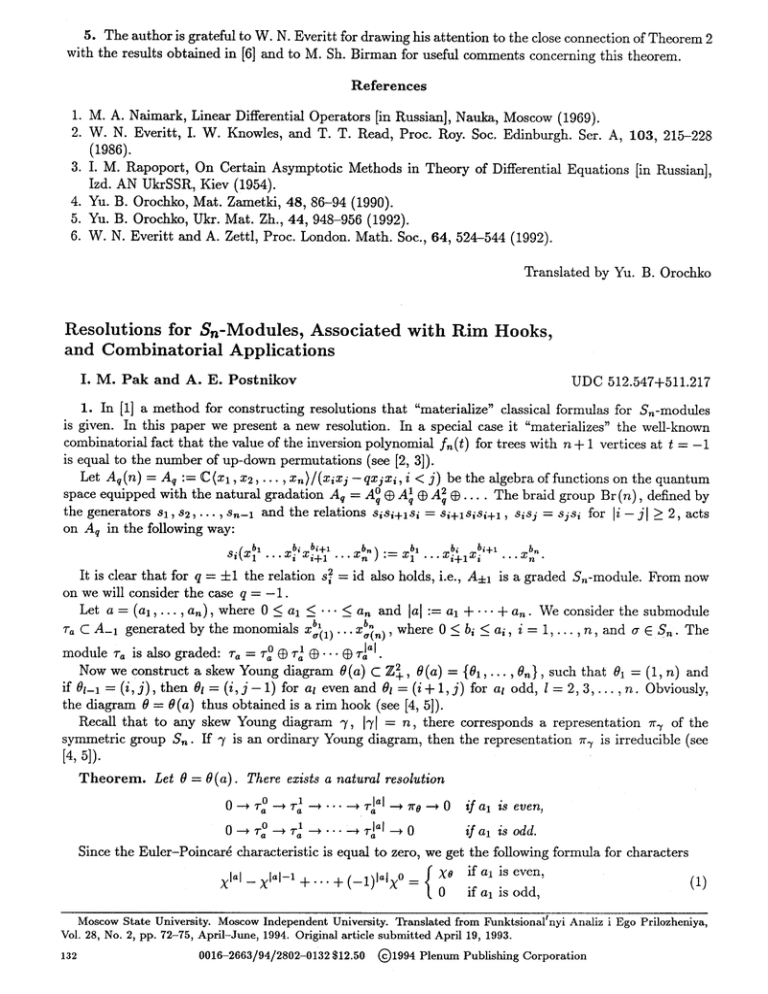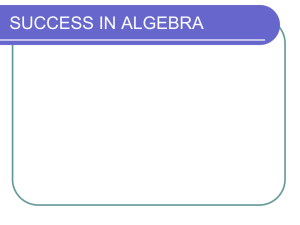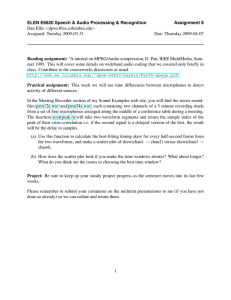Document 10500898
advertisement

5. The author is grateful to W. N. Everitt for drawing his attention to the close connection of Theorem 2
with the results obtained in [6] and to M. Sh. Birman for useful comments concerning this theorem.
References
1. M. A. Nalmark, Linear Differential Operators [in Russian], Nauka, Moscow (1969).
2. W. N. Everltt, I. W. Knowles, and T. T. Read, Proc. Roy. Soc. Edinburgh. Ser. A, 103, 215-228
(1986).
3. I. M. Rapoport, On Certain Asymptotic Methods in Theory of Differential Equations [in Russian],
Izd. AN UkrSSR, Kiev (1954)•
4. Yu. B. Orochko, Mat. Zametki, 48, 86-94 (1990).
5. Yu. B. Orochko, Ukr. Mat. Zh., 44, 948-956 (1992).
6. W. N. Everitt and A. Zettl, Proc. London. Math• Soc., 64, 524-544 (1992).
Translated by Yu. B. Orochko
Resolutions for Sn-Modules, Associated with Rim Hooks,
and Combinatorial Applications
I. M . P a k a n d A . E. P o s t n i k o v
UDC 512.547+511.217
1. In [1] a method for constructing resolutions that "materialize" classical formulas for S,~-modules
is given. In this paper we present a new resolution. In a special case it "materializes" the well-known
combinatorial fact that the value of the inversion polynomial f n ( t ) for trees with n + 1 vertices at t = - 1
is equal to the number of up-down permutations (see [2, 3]).
Let A q ( n ) = Aq := C ( x l , X 2 , . . . , X a ) / ( X i X j - q x j x i , i < j ) be the algebra of functions on the quantum
space equipped with the natural gradation Aq = A~ @ A~ @ A~ ~ . . . . The braid group Br (n), defined by
the generators sa, s 2 , . . . , sn-1 rind the relations 8isi+13 i = $ i + l S i S i + 1 , 8 i S j = 8j3i for li --Jl > 2, acts
o n Aq in the following way:
si/x l
• ""
xb,i X ib,+l
+l
'''
Xl
'''
i+lXi
'''Xn
•
It is clear that for q = +1 the relation s 2i = id also holds, i.e., A±I is a graded Sn-module. From now
on we will consider the case q = - 1 .
Let a = ( a l , . . . , a,~), where 0 _< a~ _<... _< a,~ and lal := a~ + . - . + a,,. We consider the submodule
bl
% C A_~ generated by the monomials xa(~)
... xbn
~(,), where 0 < bi <_ hi, i = 1, . . . , n, and a E S . . The
module ra is also graded: Ta = rOa @ r~a @ ' ' ' ~) Tla~1.
Now we construct a skew Young diagram 0(a) C Z~_, 0(a) = { 0 1 , . . . , 0 , } , such that ~ = (1, n) and
if Or-1 = ( i , j ) , then 0t = (i, j - 1) for at even and 0~ = (i + 1, j ) for at odd, l = 2, 3 , . . . , n. Obviously,
the diagram 0 = 0(a) thus obtained is a rim hook (see [4, 5]).
Recall that to any skew Young diagram 7, 17[ = n, there corresponds a representation ~r~ of the
symmetric group S,~. If ~/ is an ordinary Young diagram, then the representation ¢% is irreducible (see
[4, 5]).
T h e o r e m . Let 0 = O(a). There exists a natural resolution
0~¢--r~
+-..-~ralal+re---0
if al is even,
o
¢
o
is od .
Since the Euler-Poincar6 characteristic is equal to zero, we get the following formula for characters
{ X e if a~ is even,
xlal - xi~l-x + " " + (-X)I"Ix° =
0
if a~ is odd,
(1)
Moscow State University. Moscow Independent University. Translated from Funktsionaltnyi Analiz i Ego Prilozheniya,
Vol. 28, No. 2, pp. 72-75, April-June, 1994. Original article submitted April 19, 1993.
132
0016-2663/94/2802-0132
$12.50 @1994 Plenum Publishing Corporation
where X i is the character of the representation ~-~/ a n d X0 is the character of 7r0.
T h e authors also f o u n d a purely combinatorial proof of formula (1) based on the construction of an
involution on the t a b l e a u x of a special kind. T h e proof of the t h e o r e m a n d the construction of the
involution will be p u b h s h e d later.
In the r e m a i n i n g p a r t of t h e p a p e r we will consider some examples and consequences of the theorem
and continue t h e investigation of the graded S n - m o d u l e A - 1 .
2. Suppose t h a t S , acts on V = C n by the p e r m u t a t i o n of coordinates. Consider the Well algebra
E ( V ) = S ( V ) ® A ( V ) = ~ S ~ ( V ) ® A t ( V ) as a graded Sn-module, where S k ( V ) ® A t ( V ) is the component
of degree 2k + I. It can be shown t h a t A-1 is isomorphic to E ( V ) as a graded S=-module. Using the
results .of [6] concerning t h e d e c o m p o s i t i o n of the bigraded S n - m o d u l e E ( V ) , we immediately obtain the
following formula:
~
t2i + t 2 j + l
EdimH°mQrx'
A[l)t ~ =
II
1--t2h(',J) '
(2)
(i,j)eA
k=0
I,Xl =
where ), C Z~_ is a Young diagram,
[4, 5]).
~, a n d h ( i , j ) is the length of the hook at the box ( i , j ) (see
r! )o
3. Let a = ( 0 , 1 , . , n - l )
a n d fn(t) :=
d i m r ~ t ( ; ) - k . It is k n o w n t h a t f~(1) = d i m % =
(n + 1) '~-a is the n u m b e r of labeled trees with n + 1 vertices, f,~(1 + ~) = t -'~ ~ cn~t k , where c ~ is the
n u m b e r d connected graphs wigh n + 1 vertices and k edges, ~ d f~(~) is ghe inversion p o l y n o m i N for
trees wi~h n + 1 vertices (see [2, all.
We will show ghag ~he ~heorem implies f ~ ( - 1 ) = u d ~ , where ud~ is ghe n u m b e r of u p - d o w n permutations, i.e.,
~ a , := I(~ e S , I~(X) < ~(2) > ~(3) < . . . )1"
Indeed, in this c ~ e the d i a g r a m 0 = 0 (a) h ~ a "stMrc~e" form: 0 = (n, n , n - 1, n - 2 , . . . ) ~ (n - 1,
n - 2, n - 3 , . . . ). If we consider (1) ~ an identity for dimensions, we i m m e d i a t e l y obtain f ~ ( - 1 ) =
d i m 0 = u d ~ . Note t h a t ~ 0
ud~ t"/n~ = t ~ t + sect (see [2, 3]).
4. Let a = (0, k, 2 k , . . . , (n - 1)k). This c ~ e i~ a naturM generalization of Sec. 3 to k-dimensional
trees (see [7]). In this c ~ e d i m r ~ = (kn + 1) ~ - a , d i m 0 ( a ) = u d ~ , for o d d k, and dim0(a) = ~ for
~V~
~,
5. Let a = ( a n , . . . , an), al
an = k, Tnk := ra, and gnk(t) := • dimvi~t i. It can be shown
that gnu(t) = (1 + t + - - - + t~) n . For Sn-invariants the following formula holds:
.
.
.
.
.
+
d i m (Tick)s. tiz n =
E
(1 -
i,n
+
z)(1
-
(3)
zt~)...
where the r i g h t - h a n d side contains k factors. Since lira
r~k = A~_I (n) as k --~ cx~~ it follows from (3) that
~
dim(A/- ~(n))S"tiz~ = I I 1 1+-zt~i+~zt~i
E
i,n
(4)
i=0
On the other h a n d , f r o m (2) for )~ = (n) we get
E
i
d i m ( A i - l ( n ) ) S " t i = (1 + t)(1 + t a ) . . . (1 +
(1-t2)(1-t~)'"(1-t~)
t 2n-1)
Taking the s u m of the r i g h t - h a n d sides of (5) over all n a n d comparing this s u m with the right-hand side
of (4), we o b t a i n the well-known Euler identity (see [2])
c~
n
~x~
l-I i + t
n=0
i=0
l_t2i-II
i+
i=0
"
133
In this connection we note that Sn-invariants of the algebra A_I (n) are generated by the polynomials
ei(x~, ... , z~) and p~i-l(xl , . . . , x , ) , i = 1 , . . . , n, where ei are elementary and p~ are power symmetric
polynomials (e.g., see [4]).
References
1.
2.
3.
4.
5.
A. V. Zelevinsky, Funkts. Anal. Prilozhen., 21, No. 2, 74-75 (1987).
I. P. Goulden a~d D. M. Jackson, Combinatorial Enumeration, John Wiley &=Sons, New York (1983).
G. Kreweras, Period. Math. Hung., 11, No. 4, 309-320 (1980).
I. G. Macdonald, Symmetric Functions and Hall Polynomials, Clarendon Press, Oxford (1979).
G. James and A. Kerber, The Representation Theory of the Symmetric Group, Addison-Vesley, P.G.
(1981).
6. A. A. Kirillov and I. M. Pak, Funkts. Anal. Prilozhen., 24, No. 3, 9-13 (1990).
7. J. W. Moon, J. Combin. Theory, 6, 196-199 (1969).
Translated by A. E. Postnikov
The Skew Field of Rational Functions on
GLq(n,K)
A. N. P a n o v
UDC 512.554.3+512.813.4
For every field K , the ring of regular functions on the quantum matrix algebra Mq(n, K) is defined
by generators and imposed relations [1, 2]. This ring is a K-algebra and is generated, as a K-algebra,
by the elements {aij I 1 <_ i, j <_ n} and K[q, q-l]. The variable q commutes with aij , and the matrix
elements are related by the conditions aijaik : q-laikaij for j < k, akiami ~- q-lamiaki for k < m,
aijakrn -----akmaij for i < k, j > m , and aijakm - akmaij = (q-1 _ q)a.imakj for i < k, j < m. We
denote the ring of regular functions on the quantum matrix algebra Mq(n, K) by K[Mq(n, K)] or ~q.
For every e E K , e ~ O, the algebra ~q contains the ideal ~q(q- e), and we can define the specialization
~ = ~q/~q(q - e). Hereafter we will use the common notation ~q for both rings ~q and ~ , stating
explicitly whenever we use it whether q is a variable or an element of the field K .
For a permutation a we denote by l(~r) the number of inversions in the rearrangement ~(1), ... , or(n).
The quantum determinant detq is an element of the algebra ~q that is the sum ~-~(_q)-t(a)ala(1).. " ana(n)
over all permutations a E Sn. If q is generic (i.e., q is either a variable or an element of K that is not a
root of unity), then the quantum determinant generates the center of the ring ~q [1].
P r o p o s i t i o n 1 [2, 3, 5]. The ring ~q is a Noetherian integral domain.
The ring K[GLq(n)] of regular functions on the quantum group GLq(n, K) is defined as a localization
of the ring ~q by the multiplicative subset generated by detq. The ring K[GLq(n)] is also a Noetherian
integral domain. A Noetherian integral domain has a skew field of fractions [4, Theorem 3.6.12]. The skew
fields of fractions of the rings K[GLq(n)] and ~q coincide.
D e f i n i t i o n 1. The skew field of fractions Fract K[GLq(n)] will be called the skew field of rational
functions on the quantum group GLq(n, K) and denoted by K(GLq(n)) or Fq.
The main purpose of this article is to describe the skew field of fractions Fq in simpler terms. To this
end, we consider algebras of twisted polynomials and their skew fields of fractions.
D e f i n i t i o n 2. Let S = (s(i, j)) be a skew-symmetric Z-matrix of size t × t. The algebra of twisted
polynomials is a K-algebra Aq(S) generated by X l , . . . , xt and K[q, q-l] with the relations xixj =
qS(i'J)xjxi and qxi = xiq.
P r o p o s i t i o n 2. The ring Aq(S) is a Noetherian integral domain.
Samara State University. Translated from Funktsional~nyi Analiz i Ego Prilozheniya, Vol. 28, No. 2, pp. 75-77, AprilJune, 1994. Original article submitted April 2, 1993.
134
0016-2663/94/2802-0134512.50
(~)1994Plenum Publishing Corporation

![1. Compute the length of the C[x, y]-module − x − y](http://s2.studylib.net/store/data/010491183_1-48e1d3882a4736062ba8bdead01dd538-300x300.png)


